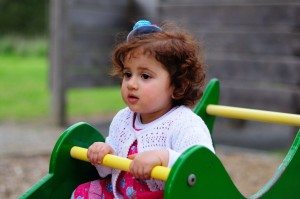
Role of Environment in Development of Play is extremely important. Play is an act of pleasure for a child. At any stage in his childhood, be it in infancy or in the preschool age, a child develops and learns via modifying the things around him while playing. As a child matures, he becomes physically able to perform new activities. The body muscles strengthen, the visual and auditory acuity increase and coordination between the senses improves.
Only maturation of the body doesn’t guarantee cognitive development. Research proves that ripening of the nervous system does no more than determine the possibilities of a child to learn skills. A favourable, stimulating environment is an indispensable catalyst in the process of your child’s development. Because infants and young children can only learn about things by acting on them, such environments should be provided which create opportunities to make discoveries. Actively experiencing new sights, smells, sounds, tastes and textures is more conducive to learning than passive exposure to plain, boring, dull, uninteresting environments.
An interesting environment invites children to explore! Toys and activities that are appropriate for the different stages of development engage children in satisfying and happy encounters. Adults should avoid extremes in levels of stimulation. A barren, quiet, routine environment or lack of attention deprives children of the activities and social interactions that help them learn about the people and things around them. On the other hand, an over stimulating environment which is filled with too many toys or sophisticated play things, discourages children from focusing their attention to certain objects and learning about them. Research proves that infants prefer moderately novel objects and turn away from boring or intense stimulation.
Matching the Child and the environment
The child’s environment includes visual, auditory, tactile (pertaining to touch) and olfactory (pertaining to smell) inputs that the child is able to process at different ages. Many parents observe that their baby responds to visual inputs by smiling at a familiar toy or face or by tracking a moving object. Yet, adults often overlook the child’s increasing ability to localize and detect sounds or understand the differences in taste and smell. These aspects in the child’s environment develop his sensory discrimination and contribute to cognitive development at large.
When babies begin to acquire language and speech they rely on the auditory inputs in the environment. They learn to discriminate what they hear and hence learn to speak different vowels and consonants. But long before infants actually start to talk, they enjoy the kind of conversations in which they imitate sounds made by a parent or sibling. At first they respond non verbally. They communicate through smiles, frowns, widening of the eyes or turning away from a rejected food or stranger. Later they begin to imitate sounds that they hear. When babies are spoken to during this period, they slowly become familiar with the sounds that form language. The practice and social interaction that children gain from these early experiences nurture the confidence needed to communicate effectively when speech develops.
The type of language activities that the adult selects will be determined by the child’s rate of development. Babies can be expected to understand and respond to simple questions like “Where are your eyes?” An older child will be able to follow and respond more complex questions like “What do we see with?”
Infants are constantly learning during their walking hours and are alert to the sounds, movements, visual details, colors, textures and temperatures in their surroundings.
Adults should select activities that challenge children but are not so difficult that they make them feel helpless and discouraged. It is easier to select appropriate toys for infants if parents realize that infants can fixate before they can track a moving object and can swat at objects before they can grasp them. As children mature it is useful to know that they will gain control of large body movements before they master small body movements. Children may be walking and running and still not be able to manage shoelaces and buttons easily. Once eye hand coordination begins to improve, however, other toys that encourage fine motor skills can be introduced.
So ideally as a parent you should try to match the environment to your child in order to help him learn and harness the acquired skills. At every stage certain toys or objects or learning material should be changed in his environment to enhance his exploration, discoveries and the joy of learning
If you wish to know more about Speech Therapy, kindly contact us at info@1specialplace.com
https://therakonnect.com/appointments/book/1specialplace
For more ideas check out our other blogs https://1specialplace.com/news/
